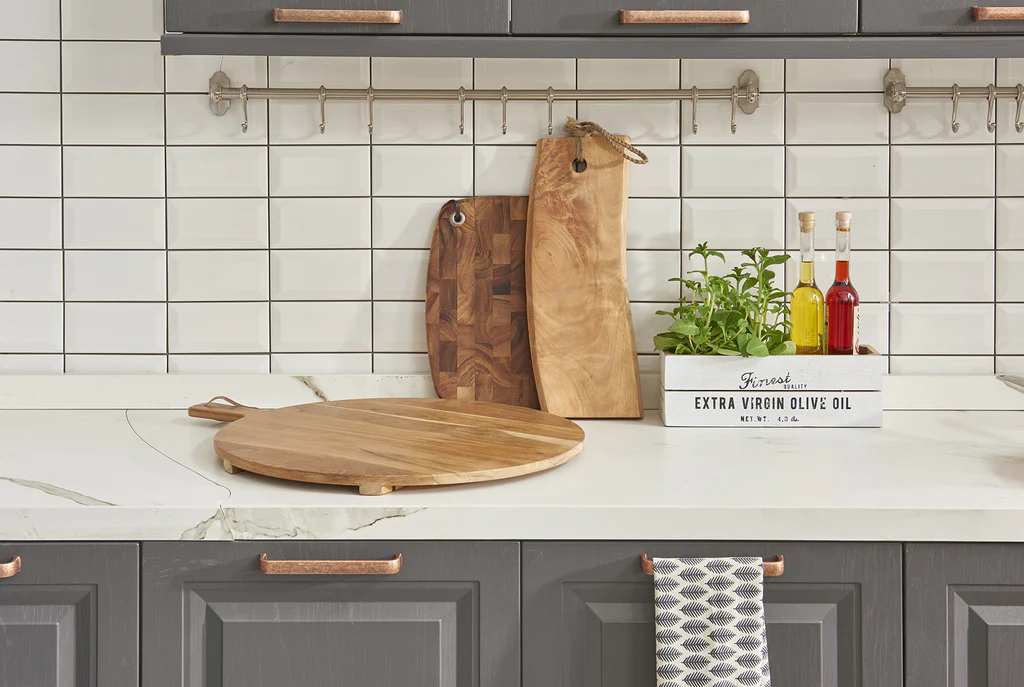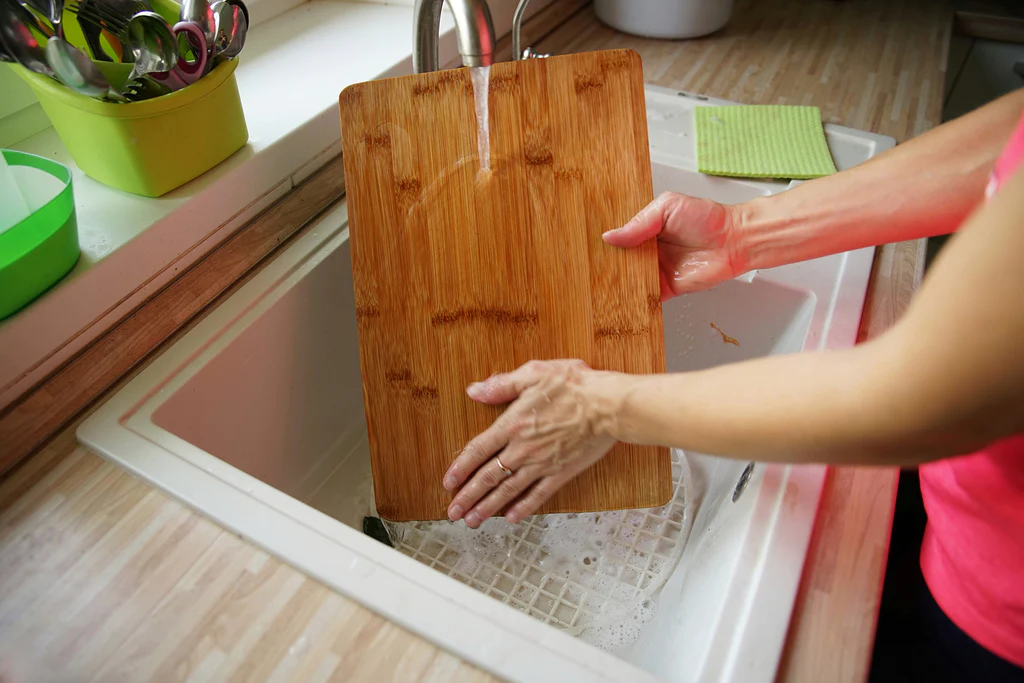Cleaning Your Wood Cutting Board
Cutting Boards And How To Clean Them
If there’s one item you can never have too many of in your kitchen, it’s cutting boards. Cutting boards are a necessity not just for keeping your countertop in good shape, but also for properly preparing meat, poultry, vegetables, and other food. A good cutting board is absolutely essential for food safety.
Wood Versus Plastic
Ultimately, the decision of whether to choose plastic or wood comes down to personal preference. Plastic boards are cheaper, lighter and require almost no care. Plastic may be better suited to people who only cook occasionally. Wood is the ideal choice if you don’t mind spending a little extra upfront and taking the time to maintain it properly.
There’s a lot to love about wood cutting boards. Wooden cutting boards are durable. A good wood cutting board can last…maybe not a lifetime, but a long, long time. They’re a pleasure to chop on and gentler on knife edges. And they’re far more beautiful than plastic ones. Wood cutting boards are also safer to use than plastic despite the fact that wood is porous. The surface of the wood absorbs bacteria, but it will sink down to the bottom layers of the wood and die, instead of staying at the surface and multiplying. One study found that this can happen as quickly as three to 10 minutes after the surface of the board being contaminated with harmful bacteria, though greasy substances like chicken fat can remain on the surface of the board and continue to be a food-safety risk for many hours; until washed properly.

Types of Wood Cutting Boards
Face grain cutting boards might be for you if on a budget and prefer wood cutting boards. Face grain cutting boards are usually thinner by design, and can be more prone to warping under heavy use. You can usually spot a face grain board by its construction of just one or very few pieces of wood. Face grain boards can be fine for lite use, however serious choppers will want to upgrade to Edge or End grain.
Tip: Face grain cutting boards are great for cutting and serving bread!
End grain cutting boards are often considered the premium option for wood cutting boards. One of the reasons chefs and prep cooks often opt for end grain cutting boards is their ability to “self-heal.” This means the cuts made on the board seal up when the board is maintained and oiled properly. Cuts made on an edge or face grain board are shallower, but they will not heal over time like an end grain board. The feat of self-healing is achieved because the vertical wood fibers separate as the knife glides across the surface. Afterwards, the fibers come back together naturally, sealing the scar. Although end grain boards usually cost more up front, properly maintained end grain cutting boards can provide years and years of commercial service.
Edge grain cutting boards are a great compromise between face and end grain boards. This type of wooden board is built by gluing several pieces of wood with the edge facing up. Edge grain boards are known for being more durable than face grain. And they are a great option for all the slicing and dicing that needs to be done to prep your venue’s ingredients. Edge grain boards will still scar over time and need to be properly washed and sanitized. To get the most of your cutting board, don’t forget to keep it oiled!

Cleaning Wood Cutting Boards to Keep Them Germ-Free
Properly maintaining and cleaning wood cutting boards requires some knowledge and work. Wood is an organic material and it needs to be cared for.
While the dishwasher is ideal for cleaning and sanitizing most things in your kitchen, you should never put a wood cutting board in the dishwasher. Water can cause the board to crack and warp. Those cracks end up becoming breeding grounds for bacteria and potentially causing foodborne illness.
If you can’t clean your board right after preparing food, just leave it on your counter until you can get to it. In some situations, you may not even need to wash it. If you’ve only sliced bread, just brush away the crumbs or wipe the surface clean with a damp cloth or paper towel.
Cleaning With Dish Soap
Luckily, cleaning a wood cutting board by hand is easy enough. All you need is very hot water, dish soap, and a brush or sponge. Rinse the board off with hot water and apply soap. Then scrub away! If you notice any knife marks, scratches or inconsistencies in the wood, make sure to give those areas an extra hard scrubbing. Scientific evidence shows that in cleaning, the volume of water matters more than anything, as it washes away bacteria and particles, so make sure you run it under lots of water and especially on scarred sections that are good at trapping food particles.
Make sure to properly clean and scrub both sides of the board even if you only used one side to cut on—meat juices can drip and contaminate the other side. Finally, be sure to thoroughly rinse off each side with hot water. Then dry off the board with a cloth or paper towel. You can also drip dry in an upright position.
Cleaning With Vinegar
Mix one part white vinegar to four parts water (hydrogen peroxide can also work if you don’t have vinegar on hand) and soak the cutting board in the solution for a few minutes. Rinse off and dry. Any vinegar other than pure white vinegar may impart smells to your board that are undesired. Note that vinegar is not registered as a disinfectant with the Environmental Protection Agency, so vinegar will only remove dirt and debris, but it won’t sanitize the surface (that is, kill microorganisms).
No matter what you soak your cutting board in, it’s important not to soak it for more than a few minutes to avoid warping or cracking the wood.
Cleaning With Lemon and Salt
Giving your cutting boards a good cleaning every month with lemon and salt is a great way to help maintain them. If your board picks up any odors from potent foods like garlic and onions, this is also a great way to deodorize it. First, sprinkle the board with coarse salt, such as sea salt or even kosher salt. Take a lemon and cut it in half. Scrub the salt down each side of the cutting board using the lemon with the fleshy side down. Let the salt and lemon solution sit for approximately five minutes. Finally, clean off the board with a sponge, rinse, and dry.
Sanitizing Your Board?
The USDA does suggest using a dilute solution of chlorine bleach and water to sanitize boards. However, this method can dry out and discolor your wood board, so we don’t recommend it. In most cases, soap and hot water are sufficient for cleaning your board.
You don’t need to disinfect your board unless you’re using it to prepare raw meat. But we’d recommend that you use a separate nonporous board (like plastic) for raw meat, poultry, or seafood, and a wood board for everything else (fruit, vegetables, or any ready-to-eat foods like bread or cheese). Plastic boards can be easily sanitized by washing them in the dishwasher without damaging them. And using a separate board helps eliminate the risk of cross-contamination.
If you do use a wood board with meat, choose bamboo. Technically a hard grass, bamboo is the least porous of the wood family, so it is less likely to absorb moisture and juices from meats, and resists scarring from knives. Hardwoods, like maple, are fine-grained, and the capillary action of such grains pulls down fluid, trapping the bacteria – which are killed off as the board dries after cleaning – making them another good option to use with raw meats. Either way, just make sure you sanitize and dry thoroughly after use.
Dealing With Mildew
If your board develops mildew (usually this looks like clusters of small black spots), it’s probably time to say goodbye to it. Mildew usually results from inadequate drying before storing. Mildew tends to collect on the very perimeter of the board, which is where you’ve been standing it up to dry. If you really want to salvage your board and you’re up for a project, the pros recommend sanding off the mildew. However, you want to be sure you’re sanding down enough of the wood to remove all of the mildew, otherwise it could return.
For restoring a damaged board
- Various grits of sandpaper: For sanding, the pros recommend using a range of sandpaper grits, from 80 to 400, depending on what you’re trying to achieve.
- A small flat box, sanding block, or orbital sander: These tools make it much easier to sand efficiently and evenly.
- A clean rag or large paintbrush: This is used to clean wood particles off your board after sanding.
How To Maintain Your Wood Cutting Board
To avoid cracking, dryness, and warping of the wood cutting board, it’s best to oil the board once a month. Keeping a wooden cutting board saturated with oil also helps protect it from stains, since it’ll be a little less eager to soak up every drop of liquid that touches it. This is a quick task and only takes a few minutes. First, meticulously clean the cutting board, preferably using the lemon and salt method described above (but any cleaning method will do). Then dry the board thoroughly.
To oil the board, you need to use a product specifically formulated for wood cutting boards or a food grade mineral oil will also work. Do not use other organic oils (olive or avocado, etc.) as the fats in those oils can and will spoil, turning rancid and causing your cutting board to stink. Use a soft cloth or paper towel in circular motions to buff the oil into the wood cutting board. Apply a thin coat to the entire surface, front and back, as well as the sides. Let the oil soak for a few hours or even overnight.

Know When To Buy A New Board
Over time, any cutting board can accumulate deep scratches or grooves that may trap bacteria even if you carefully scrub and sanitize the board between uses. As a result, pathogenic microorganisms transmissible through food may build up or accumulate. These microorganisms may be transferred to foods that are prepared on such surfaces. When your cutting board becomes heavily scared from repeated use, replace it. The more grooves it has, and the bigger they are, the more area is available for trapping moisture and giving bacteria a place to proliferate.
Plastic cutting boards are easier to sanitize. But cutting on them also leaves lots of grooves where bacteria can hide. This means you may go through a plastic cutting board every few months, which isn’t very cost-effective or good for the environment.
Wood is tougher to sanitize, but it’s also (often) tougher in general – you won’t find as many deep scratches in the surface. In addition, researchers have discovered that the type of wood your cutting board is made from also makes a difference. Hardwoods, such as bamboo and maple, are less prone to scarring than softer woods, such as cypress. And unlike plastic, wooden cutting boards don’t need to be thrown out when they do get cuts. Just sand the surface down with a fine-grit sandpaper (see above), wash it, dry it and then rub it down with a bit of mineral oil. It’ll be good as new.
All in All
With only a few minutes of care, you can easily keep any cutting board in pristine condition for years to come, not to mention keep your prime working surface sanitary for you and your guests!
